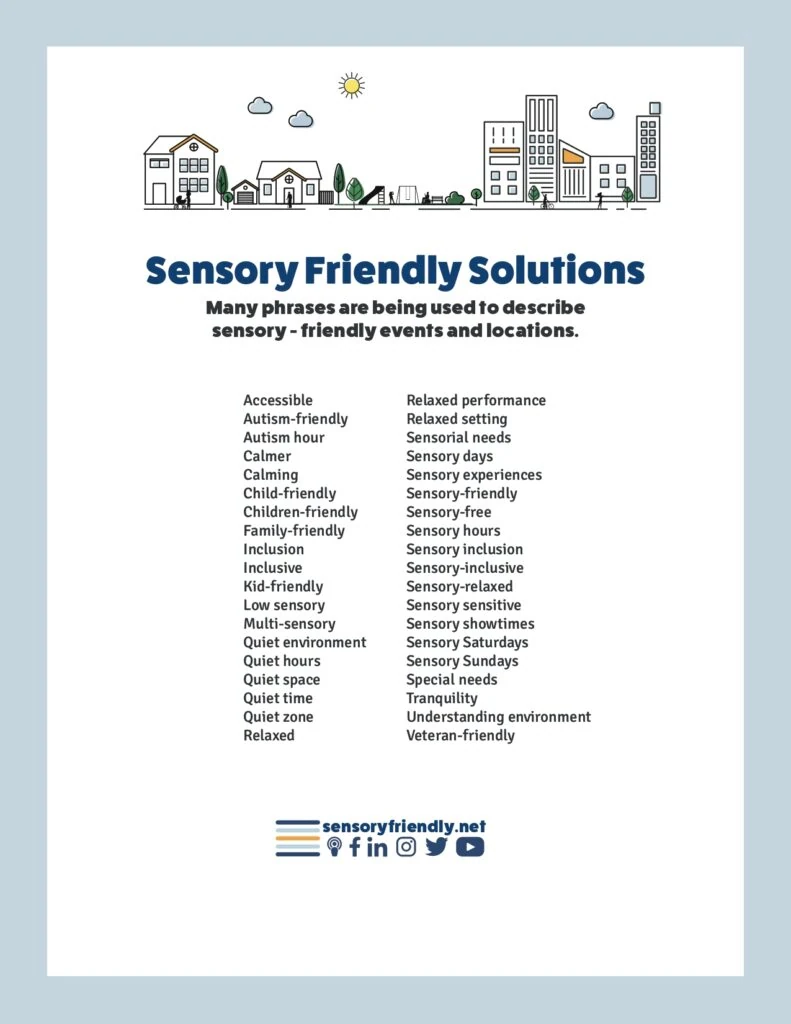Table of Contents
Help is here to understand the meaning of sensory friendly. In addition, you will also learn about your senses.
First, know that sensory refers to any single sense. However, it also can refer to any of your eight senses.
Second, your senses include what you see, hear, taste, touch, smell. Likewise, they also include your sense of movement, balance, and internal body sense. So, you have more than 5 senses. In fact, you have at least eight senses!
Meanwhile, friendly, in this context, means a change to the experience. Thus the experience becomes more pleasant overall. As well, it has fewer challenges for the senses. For example, think of the expression, “less is more”. Therefore, sensory-friendly means the sensory experience is less. Thus, sensory-friendly tries to be calmer. It tries to be pleasant. Finally, it is is less intense or extreme.
For instance, sensory-friendly is less jarring to the senses. Less bothersome to a single sense. And more importantly, less bothersome to the senses combined. At locations or events, sensory-friendly means less background noise. For example, background music is turned off. There will be fewer sudden noises. No announcements. Sensory-friendly also means changes to lights. This does not mean that the lights are off. But it does mean there would be no bright spot lights. No flickering lights. No flashing lights. Sensory-friendly is scent-free too. Finally, there are other changes that can happen. Modifications can be made for other senses too. They all help an event or location become more sensory-friendly.
Sensory-friendly is happening everywhere
Meanwhile, there is help for people trying to find sensory-friendly experiences. That includes people with sensory sensitivity. They are people who experience sensory overload in daily life. Sensitivity and overload is also a problem for their families. And their friend group, when they do things together. Many people look sensory-friendly in everyday life. Research, “Caregiver Perceptions of Child Participation in Sensory Friendly Community Events” by DeBoth et al., (2021) found that sensory-friendly changes improve comfort, enjoyment and participation among children with sensory sensitivities 1.
Additionally, sensory-friendly businesses and organizations emerge every day. And they do so around the world. The number of sensory-friendly organizations is always increasing. Locations, events, products, and services are becoming sensory-friendly. They all help people with sensory sensitivity and sensory overload.
On the other hand, there are different phrases that describe sensory-friendly. That is because sensory-friendly helps people with different underlying conditions. Examples are anxiety, autism, concussion, hearing loss, PTSD, and sensory processing disorder.
A list of words that may mean sensory-friendly:
A
- Accessible
- Autism-friendly
C
- Calmer
- Calming
- Child-friendly
- Children-friendly
F
- Family-friendly
I
- Inclusion
- Inclusive
K
- Kid-friendly
L
- Low sensory
M
- Multi-sensory
Q
- Quiet environment
- Quiet hours
- Quiet space
- Quiet time
- Quiet zone
R
- Relaxed
- Relaxed performance
- Relaxed setting
S
- Sensorial needs
- Sensory days
- Sensory experiences
- Sensory-friendly
- Sensory-free
- Sensory hours
- Sensory inclusion
- Sensory-inclusive
- Sensory-relaxed
- Sensory sensitvie
- Sensory showtimes
- Sensory Saturdays
- Sensory Sundays
- Special needs
T
- Tranquility
U
- Understanding enviroment
V
- Veteran-friendly
Who becomes sensory-friendly?
The world is more busy, loud, and overwhelming. As a result, more people look for ways to enjoy life. In addition, people want to avoid sensory overload. This includes people with several conditions, disabilities, or challenges. More examples are anxiety, autism, concussion, dementia, and PTSD. People with sensory sensitivity look for sensory-friendly at home, at school, and at work. As well as things to do in their community. And finally, when they travel. Being sensory-friendly means people can find locations, events, products, or services that meet their needs.
Furthermore, many organizations and businesses look for ways to help their customers. They want to help this large group of people. Subsequently, they want to build an accessible, inclusive location or event. As well as an accessible, inclusive experience. One that helps their customers enjoy what they have to offer. Finally, it helpful to know that sensory-friendly, accessible inclusive locations or evens also helps their employees!
Examples are:
- dentists
- movie theatres
- musicians and theatres
- healthcare offices
- therapists
- stores and shopping malls
Learn more about the meaning of sensory-friendly and who adopts this approach in a newspaper article.
An infographic with the words describing the meaning of sensory-friendly
Below is a helpful infographic. As an example, it has a list of words used to give the meaning of sensory-friendly. Finally, you can download the infographic with the many phrases used to describe sensory-friendly events and locations.

Christel Seeberger has worked in health care for 30 years, including helping people with sensory sensitivity who experience sensory overload. Christel has a hearing disability and experiences sensory sensitivity and sensory overload herself. She founded Sensory Friendly Solutions in 2016 to make the world more sensory-friendly, accessible and inclusive.
Source
- DeBoth, K., Wendland, M., Bilinovic, T., & Sanford, C. (2021). Caregiver Perceptions of Child Participation in Sensory Friendly Community Events. Journal of Occupational Therapy, Schools, &Amp; Early Intervention, 14(3), 291–306. https://doi.org/10.1080/19411243.2020.1862729



